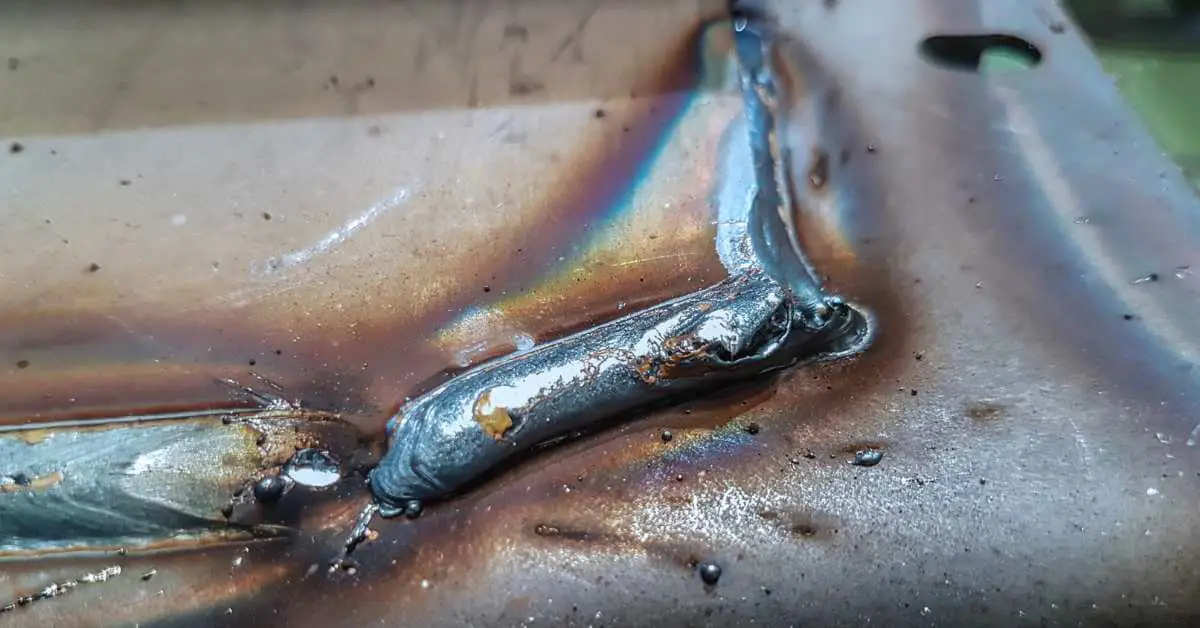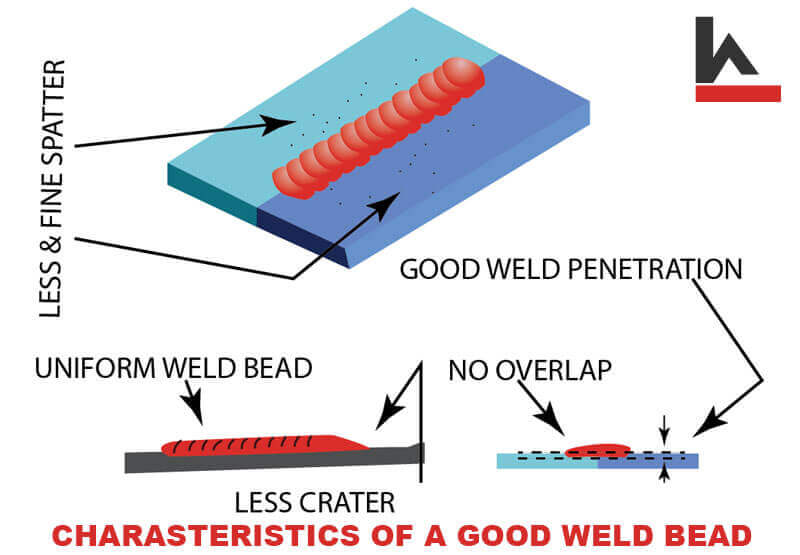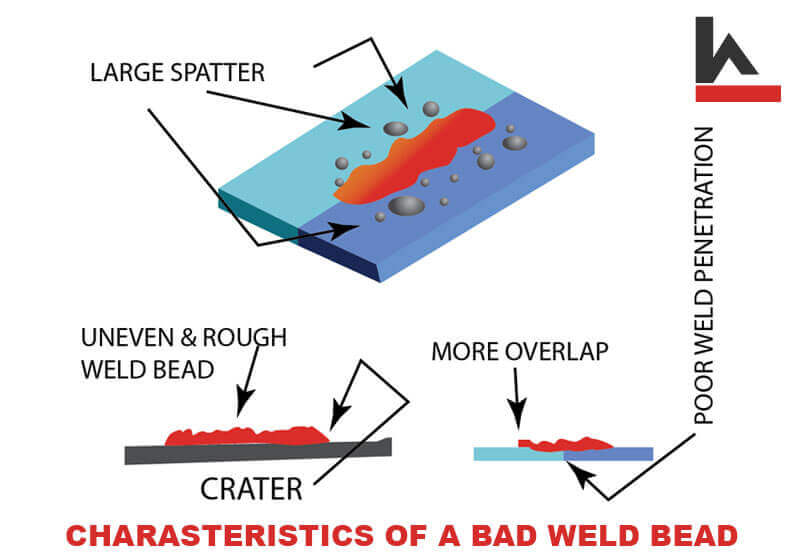Welding is a key process in the fabrication and repair of metal structures. A weld’s quality directly impacts these structures’ integrity and safety. Being able to distinguish between a good weld, which forms a strong and durable joint, and a bad weld, which can lead to weakness and potential failure, is essential.
In this article, we will explore the principal characteristics of good welds and bad welds, along with tips on how to identify them. Whether you are a professional welder or simply curious about the process, you are better equipped to ensure the consistent production of high-quality, safe, and durable welded structures.
Characteristics of a Good Weld | Qualities of a Good Weld
Examining welds requires observing certain features to ensure a strong and reliable joint. Several key aspects differentiate good welds from bad ones.
Firstly, adequate penetration is essential. A well-executed weld means the filler metal has entirely fused with both base materials, providing the best joint strength and durability.
Uniformity is also crucial, as it reflects proper heat distribution during welding. A good weld maintains consistent weld bead width and height and is flush with the base metal. In contrast, uneven widths or heights might indicate the welder had poor heat control or used incorrect techniques, jeopardizing the joint’s integrity.
A well-performed weld demonstrates minimal porosity and undercut, as gas pockets and excessive melting can weaken the structure. Visual inspection can reveal a quality weld by its smooth, even weld surface and minimal spatter, showcasing the welder’s expertise and care. Let us make a list of characteristics of a good weld:
- A straight weld bead of uniform thickness and no bumps (weld looks good).
- The weld size is consistent over the length (width, thickness, and height).
- The cross-section of the weld bead nearly matches the desired shape and size of the designed weld joint.
- No discontinuity in welding.
- No visible cracks undercut, burnouts, overlap, and porosity.
- In the case of TIG welding, a good weld will appear as multiple tiny welds layered neatly one over another.
Characteristics of a Bad Weld | Spot a Bad Weld
A bad weld can be recognized by certain characteristics that indicate poor quality and potential issues. These include:
- Lack of fusion: The weld fails to fully penetrate and fuse with the base metal, resulting in a weak joint that is more prone to failure.
- Erratic or uneven bead: The weld bead is inconsistent, indicating a lack of weld uniformity in the welding process.
- Excessive globules of molten metal: This can be a sign of excessive heat or improper torch manipulation.
- Undercut edges: The weld erodes the base metal, creating a groove or undercut along the weld edges.
- Lack of penetration or insufficient weld size: The weld does not penetrate deeply enough or is not of adequate size.
- Cracking, porousness, and overlapping: These indicate poor quality and can compromise weld integrity.
Recognizing and addressing these characteristics is essential for ensuring the quality and strength of a weld.
Related Article: Welding Defects: Causes and Remedies | Common Types of Welding Defects
Different Welding Processes: TIG, MIG, Stick
Let’s now discuss the critical factors differentiating a high-quality weld from a poor one. By understanding these distinctions, you can evaluate welded joints’ structural integrity and safety.
Distinct Pattern: Spot a Good Weld vs Bad Weld
A distinct pattern is a crucial indicator when determining the quality of a weld. A good weld displays a distinct pattern that differentiates it from a bad weld. The weld pattern should follow a straight path without waviness, and the bead width should be consistent from beginning to end with no irregularities.
The bad weld may lack a distinct pattern, making it easily identifiable. The bead width may be erratic, varying in size or shape. This inconsistency suggests a lack of control during welding, which can compromise the weld’s quality and integrity.
TIG (Tungsten Inert Gas) Welding: Spotting Good TIG Welds
TIG welding is a useful, versatile, and precise process for various metals such as carbon steel, alloys, aluminum, etc. It requires extensive skill as it uses a non-consumable tungsten electrode and a separate filler material introduced separately.
Achieving the optimal balance and control between the welding torch, filler material, and foot pedal is essential. Quality results exhibit a uniform, precise layered bead pattern.
A good TIG welding weld bead fuses perfectly with the base metal has a consistent bead width, and is distortion-free. A porous output, lack of pattern, or typical sloppiness is an indication of poor TIG welding.
Bad TIG welds may display irregular bead shape and width, excessive spatter, or a visible lack of fusion. These imperfections can weaken the weld and make it more prone to failure.
Characteristics of a Good TIG Weld
- The weld bead consists of neatly layered little welds one above the other.
- The cross-section of the weld bead nearly matches the desired shape and size of the weld joint.
- The weld bead has a good pattern and is pleasing to the eyes.
- Uniform and straight weld bead
- No burnout, visible cracks, etc.
MIG (Metal Inert Gas) Welding: Distinguishing Good MIG Weld from a Poor Weld
MIG welding offers versatility and simplicity, making it a go-to welding process for many. It is effortless and suitable for different types of metals like mild steel, stainless steel, and aluminum. The welder feeds a wire electrode that acts as the filler material and electrode.
A good outcome features a uniform, straight line with a smooth surface, free from defects such as holes or undercut edges. Good wire clean-up, as failure to do so may introduce contaminants, impacting the output’s quality.
A poor MIG weld is characterized by uneven weld beads, indicating poor control and technique during welding.
Porosity, or tiny holes within the weld, is another common sign of an inadequate weld, weakening the joint. Undercut, wherein the edges of the weld melt away, can further compromise the stability of the structure. A lack of fusion, or the failure to melt the base metal entirely, can also cause issues.
Characteristics of a Good MIG Weld
- The weld bead is straight and uniform over its complete length.
- No visible cracks, burn holes, undercuts, porosity.
- The cross-section of the weld bead nearly matches the desired shape and size of the weld joint.
- The weld bead does not have craters and dips.
- No discontinuity, or crater, in the weld bead.
- The weld bead is smooth and consistent in size (width and height).
Stick Welding: Identifying Good Stick Weld vs. Bad Stick Weld
Stick welding is versatile and suitable for various materials. It requires a consumable electrode coated with flux to shield the molten metal from oxidation or contamination.
A good stick weld exhibits uniformity and consistency in an even bead, pattern, and appearance. Quality outputs are spatter-free, with the filler metal fused correctly with the base metal. Similar features characterize excellent welds; a flat, clean bead with adequate penetration and even width.
A bad stick weld can be easily identified by its poor qualities. The bead may need more consistency, appearing uneven or irregular in width.
Excessive spattering and spatter drops on the surface can also indicate a bad weld. Visible lack of fusion or undercut are signs of insufficient penetration and can greatly compromise the integrity of the weld.
Characteristics of a Good Stick Weld
- Uniform and straight weld bead.
- The weld size is consistent (width, thickness, and height) over the complete weld length.
- The cross-section of the weld bead nearly matches the desired shape and size of the weld joint.
- No visible cracks, spatters, undercuts, and porosity.
- No discontinuity in welding.
- No excessive convexity or concavity in the weld bead.
- The Weld bead is continuous and covers the complete length of the weld groove.
Gas Welding Method: Determining a Quality Weld with Oxyacetylene
Oxy welding is useful in repairing and cutting metals. It features a mixture of fuel, oxygen and gas to create a high-temperature flame melting the metal pieces to be joined.
Quality outputs entail consistent and uniform beads with adequate penetration. Smooth and even, they’re free from any holes or globules of molten metal. Excessive heat, improper torch manipulation, or incorrect filler material choice lead to poor oxy welding.
A bad oxy weld is characterized by inadequate penetration, meaning the metals are not fully melted, making the joint weak and prone to breakage.
Excessive globules of molten metal, oversized or undersized beads, and joint overlap are other significant indicators of poor oxy welding. Furthermore, undercut and insufficient fusion, with poor bonding of the base metals, can also severely damage the structure.
Characteristics of a Good Oxy Acetylene Welding
- Uniform weld bead over the complete weld length.
- No holes.
- Good penetration.
- The area around the weld bead is clean.
Good Welds Vs Bad Welds | Identify a Good Weld from Bad Weld
Let us summarize good and bad welds concerning stick welding, MIG welding, TIG welding, and gas welding.
| Characteristics of a good SMAW weld | Characteristics of a bad SMAW weld |
|
|
| Metal Inert Gas Welding or MIG Welding | |
| Characteristics of a good MIG weld | Characteristics of a bad MIG weld |
|
|
| Tungsten Inert Gas Welding or TIG Welding | |
| Characteristics of a good TIG weld | Characteristics of a bad TIG weld |
|
|
| Oxy Acetylene Gas Welding | |
| Characteristics of a good Gas weld | Characteristics of a bad Gas weld |
|
|
Preventing Bad Welds: Best Practices and Tips
A good weld requires skill, precision, and knowledge of proper welding techniques. What differentiates a good weld from a poor one are several factors, each affecting the quality of the weld.
Proper voltage, travel speed, filler metal, electrode manipulation, wire feed speed/amperage, and shielding gas are some crucial factors affecting weld quality.
Let’s explore these factors more and understand what to look for when setting up your welding machine:
1. Proper Voltage
- Correct voltage ensures optimal arc control and consistent penetration.
- Too high voltage leads to poor arc control and erratic bead with poor fusion.
- Too low voltage causes inconsistent penetration and weak weld joint.
- Excessive spatter and a convex bead profile are signs of improper voltage settings.
- Regular visual inspection and adjustment of voltage are necessary for high-quality welds.
2. Travel Speed
- Travel speed determines the quality of a weld.
- Too fast speed results in a narrow, convex bead with weak tie-in at the weld’s toes.
- Too slow speed leads to excessive heat, wide beads, and compromised joint integrity.
- Optimal speed allows control over the arc, achieving sufficient penetration and proper tie-in.
- Striking the right balance is vital for strong and visually appealing welds.
3. Filler Metal
- Appropriate filler metal ensures strength and integrity of weld joint.
- An oversized filler rod creates uneven welds with excessive heat and potential defects.
- Using a small filler rod leads to inadequate weld size and insufficient penetration.
- Base metal composition and thickness should guide the selection of filler metal.
- Weld quality can be assessed using tools like a fillet weld gauge.
4. Manipulation of the Electrode
- Skilled electrode manipulation is crucial for achieving a good weld, especially in advanced techniques like TIG welding.
- Precise control and coordination are necessary for controlling bead size, penetration, and shape.
- Varying travel speed, angle, and weaving motion help distribute heat evenly and prevent defects.
5. Wire Feed Speed/Amperage
- Proper wire feed speed and amperage are critical for good welds.
- Setting them too high or too low can have significant consequences.
- Incorrect wire feed speed results in poor arc control and inconsistent penetration.
- Wrong amperage leads to inconsistent weld penetration, excessive spatter, or inadequate tie-in.
- Manufacturer’s recommendations should guide proper settings.
6. Shielding Gas
- Shielding gas protects the weld from atmospheric contamination.
- Proper setup and flow rate are crucial.
- Correct connection and attachment of gas nozzle or diffuser to prevent gas leaks.
- Flow rate should maintain a steady and smooth flow to protect the weld zone.
- Choice of shielding gas depends on the base material being welded.
By better understanding these factors, welders can produce high-quality welds that meet industry standards.
FAQs About Weld Quality and Identifying Good vs Bad Welds
How do I inspect the quality of a weld?
Welds can be visually inspected using techniques like liquid penetrant testing, magnetic particle inspection, or more advanced methods like radiographic testing or ultrasonic testing.
Visual inspection is the most common method, involving an examination of the weld for signs of defects or inconsistencies.
How can I identify bad welds?
Bad welds often exhibit visual signs such as undercut edges, lack of fusion, erratic bead appearance, or even a visible lack of penetration. These defects can weaken the joint and compromise its integrity.
Are the welding tools and equipment crucial for creating a good weld?
Yes, a good weld can be achieved using the proper welding equipment and tools. The key factors for achieving a good weld are understanding the welding process, selecting appropriate equipment and tools, and having skilled operators.
Each welding equipment type has its advantages and limitations, so it’s crucial to choose the right one for the specific application.
What are the potential long-term effects of a bad weld on the structural integrity of the welded object?
The potential long-term effects of a bad weld on the structural integrity of the welded object can be severe. A bad weld may lead to weak joints, increased susceptibility to fatigue cracking, and reduced load-carrying capacity.
Over time, these issues can compromise the overall strength and stability of the welded structure. It’s crucial to ensure proper welding techniques, materials, and inspections are employed to avoid such detrimental consequences.
Conclusion
In conclusion, the quality and integrity of welding play a crucial role in maintaining strong and durable structures. NDT Testing Procedures help identify weld faults, ensuring accurate weld classification.
Welding experts employ these tests not only to guarantee the structural integrity of their work but also to find ways of refining their practice. Understanding the difference between a good weld and a bad weld and employing comprehensive testing procedures is fundamental to successful and reliable welding projects.








